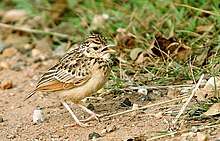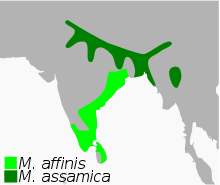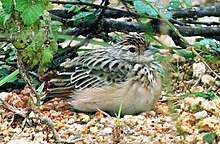Jerdon's bush lark
Jerdon's bush lark (Mirafra affinis) or Jerdon's lark is a species of lark in the family Alaudidae found in south Asia. This was formerly considered as a subspecies of Mirafra assamica and termed as the Madras bushlark. Two other species in the complex include Mirafra marionae and Mirafra microptera. Jerdon's bush lark is typically very pale on the underside
| Jerdon's bush lark | |
|---|---|
 | |
| A juvenile near Bangalore, India | |
| Scientific classification | |
| Kingdom: | Animalia |
| Phylum: | Chordata |
| Class: | Aves |
| Order: | Passeriformes |
| Family: | Alaudidae |
| Genus: | Mirafra |
| Species: | M. affinis |
| Binomial name | |
| Mirafra affinis Blyth, 1845 | |
 | |
| range in bright green | |
| Synonyms | |
| |
Taxonomy and systematics
The common name commemorates the surgeon-naturalist Thomas C. Jerdon.[2]
Formerly, Jerdon's bush lark was considered to be a subspecies of the Bengal bush lark (as M. assamica affinis) until studies of differences in call and distribution led to it being treated as a separate species.[3] However, not all authorities recognize this species split.[4]
Description

Jerdon's bush lark has arrowhead-like spots pointing upwards on the breast. It is very similar to the Indian bush lark (M. erythroptera) but has buffy lores, less white behind ear coverts, darker center to wing coverts and central tail feathers. Dark centers of primary coverts are prominent, and wing panels are duller and rufous. In the southern Western Ghats, the race ceylonensis is darker and more rufous on the underside and has a longer bill.[5] Jerdon's bush lark has paler, greyish-brown underparts.
The song of Jerdon's bush lark is a dry rattle given from its perch.[3]
Distribution and habitat
Jerdon's bush lark has a large range in south-east India and Sri Lanka, with an estimated global extent of occurrence of 100,000-1,000,000 square kilometers.[6]
It has proven adaptable to a variety of open habitats up to a maximum elevation of 1500 m. Some of these are forest perimeters, rocky scrubland, scrubby hill meadows and clearings in open-type forests, shrub-edged unused croplands, and thickets of bamboo.[6]
Behaviour and ecology
Its song-flight is similar to that of the Indian bush lark, However, unlike the aforementioned species, Jerdon's bush lark often perches on trees and wires.[5]
References
- BirdLife International (2012). "Mirafra affinis". IUCN Red List of Threatened Species. 2012. Retrieved 26 November 2013.CS1 maint: ref=harv (link)
- Beolens, Bo; Watkins, Michael (2003). Whose Bird? Men and Women Commemorated in the Common Names of Birds. London: Christopher Helm. pp. 180–181.
- Alström, Per (1998). "Taxonomy of the Mirafra assamica complex" (PDF). Forktail. 13: 97–107. Archived from the original (PDF) on March 7, 2008. Retrieved May 1, 2009.
- "Mirafra affinis - Avibase". avibase.bsc-eoc.org. Retrieved 2016-11-28.
- P.C. Rasmussen & J.C. Anderton (2005). Birds of South Asia. The Ripley Guide. Lynx Edicions.
- Compiler: Helen Temple (2008). "Jerdon's Bushlark - BirdLife Species Factsheet". Evaluators: Jeremy Bird, Stuart Butchart, Helen Temple. BirdLife International. Retrieved May 9, 2009.
| Wikimedia Commons has media related to Mirafra affinis. |
